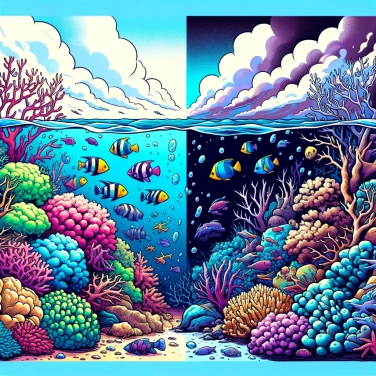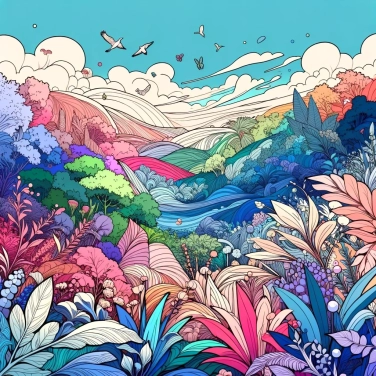Coral reefs are in danger due to climate change, pollution, overfishing, destruction of coastal habitats, and ocean acidification, among other factors.

Plastic and chemical waste thrown into the sea or coming from land is a real headache for coral reefs. Plastics, for example, suffocate or break fragile corals. Chemicals from agriculture or industries lead to the proliferation of invasive algae that take up all the space and deprive corals of energy, blocking the light they need. Toxic chemicals, agricultural residues, or domestic pollution create a true soup that clouds the water, reduces its quality, and severely harms corals. When the water becomes murky, reefs are deprived of light and oxygen, which directly affects their growth and survival.
When the water temperature rises by just a few degrees, corals become stressed, panic severely, and expel the micro-algae essential for their survival, called zooxanthellae. Without these algae, the coral loses its vibrant color and turns pale — this is the famous coral bleaching. And it's not just an aesthetic issue: without their plant partners to provide them with food and energy, corals gradually die. The problem is that episodes of extreme heat are becoming more frequent and lasting longer due to climate change, leaving very little time for reefs to recover. The result? We risk losing a large part of these ultra-rich ecosystems in biodiversity that are essential to the oceans.
Some fishing practices are downright devastating for corals. Blast fishing, for example, involves throwing explosives into the water to easily kill many fish at once. The problem is that the explosion literally shatters the reefs, causing long-term damage that is almost impossible to repair.
Another equally destructive practice is cyanide fishing: fishermen use this poison to stun live fish and then easily capture them for exotic aquariums or restoration. As a result, marine life all around is contaminated or destroyed, and the reef takes a severe hit.
Even some nets used by fishermen, particularly drift nets or bottom trawls, scrape or tear corals directly in their path. It’s like running a bulldozer underwater. Often, all that’s left behind is sterile sand and some debris. These destroyed reefs take years, even decades, to come back to life—if they even manage to do so.
Coral reefs can be attacked by different coral diseases, often caused or exacerbated by bacteria, fungi, or viruses. These diseases, such as white band disease or yellow band disease, directly attack the living tissues of the coral and can cause their death at a rapid pace. Alongside this, certain invasive species, like the starfish known as crown-of-thorns, devour corals en masse and quickly. When these starfish invade, they can transform a colorful and vibrant reef into a marine desert within a few months. Such invasions and diseases often worsen when the reefs are already weakened by pollution or water warming.
Coastal areas are often overrun to build hotels, ports, or even roads, which means that coastal habitats are regularly destroyed to make way for tourists. Construction also generates a lot of sediments that flow directly into the water. This clouds the water and prevents corals from receiving enough light to survive. The thing is, the more tourists there are, the more pollution there is: plastic waste, chemical sunscreen, untreated wastewater being discharged directly into the sea... All of this works together to suffocate the reefs. Not to mention the activities of the tourists themselves, such as walking or anchoring directly on the corals, which permanently damages their fragile structure.
Although coral reefs cover only 0.1% of the ocean's surface, they are home to about 25% of known marine species, playing a crucial role in marine biodiversity.
Coral is not a plant, but an animal. Each coral reef is actually a massive colony made up of thousands of tiny polyps living in symbiosis with microscopic algae.
It is estimated that more than 500 million people around the world depend economically, directly or indirectly, on coral reefs for their food resources or tourism income.
A healthy coral reef can reduce wave energy by nearly 97%, protecting coastlines and significantly limiting damage caused by storms and coastal erosion.
Coral reefs provide multiple benefits: they host an incredible marine biodiversity, contribute to the protection of coastlines against erosion and storms, ensure the economic livelihood of millions of people through tourism and fishing, and serve as natural laboratories for biomedical and pharmaceutical innovations.
You can take action in various ways: reduce your carbon footprint to slow down global warming, use ocean-friendly cosmetic and sunscreen products (specifically those without oxybenzone), avoid any contact with corals during water activities, prioritize sustainable consumption of fish and seafood, and get involved in local information and awareness-raising initiatives.
Intensive tourism can significantly damage coral reefs through direct trampling, waste produced, water pollution due to tourist infrastructure, and boat anchoring on the reefs. The associated coastal urbanization also disrupts fragile marine ecosystems.
Yes, some species of corals show better resistance to rising temperatures or ocean acidification. Scientific research is currently being conducted to identify and study these more resilient corals, known as 'super corals', in order to ultimately help reefs survive and combat their decline.
Coral reefs turn white due to a phenomenon called bleaching, primarily caused by ocean warming. When the waters become too warm, corals expel the symbiotic algae (zooxanthellae) that provide them with nutrients and color. Deprived of these algae, corals lose their coloration, become white, and weaken significantly.

No one has answered this quiz yet, be the first!' :-)
Question 1/5